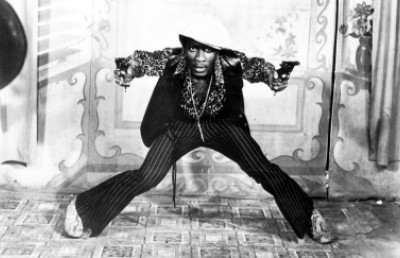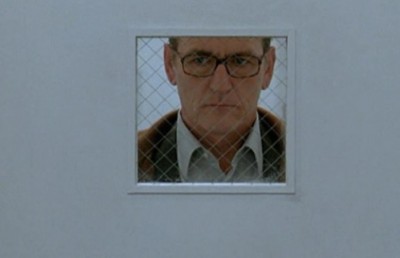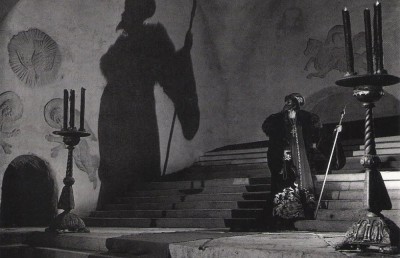The Happening
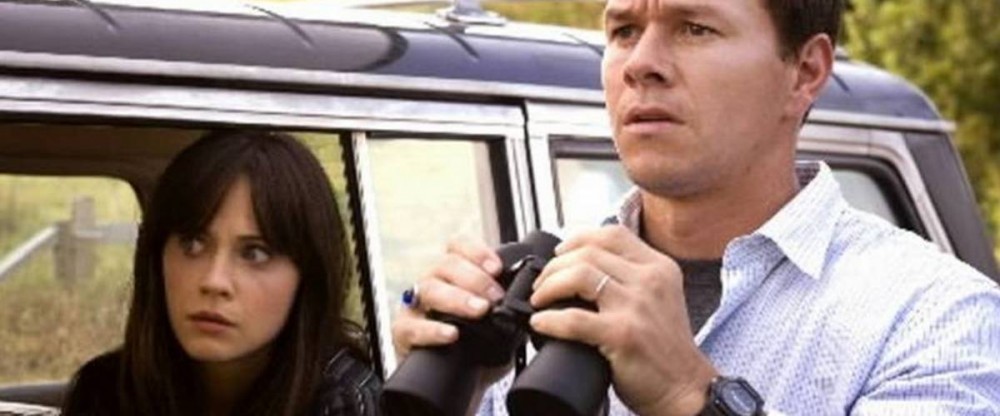
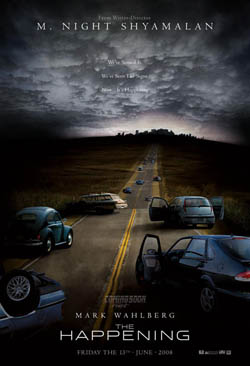
The Happening is in most respects what you would expect from a film by M. Night Shyamalan, which can mean something entirely different depending on your perspective and attitude toward Shyamalan. All things considered, I take this to mean that it is a good film that is better than the usual Hollywood fare because —in the end— it is intelligent cinematically. Shyamalan doesn’t stretch himself here and we can see a Shyamalan formula beginning to emerge: begin with a cataclysmic event which is unexplainable and then play it out with characters trying to survive the event, understand it, learn something about themselves from the experience, and come out better for it. As part of the formula, add in a couple in relationship distress, in this case a kind, level-headed science teacher Elliot Moore (Mark Wahlberg), and his withdrawn wife Alma (Zooey Deschanel).
One thing is certain, the film begins with a bang, starting from the opening credits which foreshadow the theme of nature ‘turning dark’: happy, blue clouds slowly darken during the credit roll until they become ominously black. Cut to New York Central Park, where a normal day starts to turn surreally abnormal. People suddenly stop in their tracks and seem to freeze up, echoing a composition from Antonioni’s Red Desert. Others begin to walk backward. A lady sitting on a park bench reading takes her hairpin out and thrusts it into her neck. The scene cuts to a building construction site, introducing a group of workers standing around chatting, joking. The levity is broken by the sound of a heavy thud, caused by a worker falling to the ground. As they rush to his side another corpse falls a few feet away. Then another, then another. The tension is raked higher with a cut to a low angle POV of a slow motion shot of other workers jumping off the top of the half-built building, an eerie replay of the 9/11 suicidal jumps off the burning twin towers
The powerful yet enigmatic opening sequence cuts to high school science teacher Elliot (Mark Wahlberg) in his classroom, querying students as to why a certain species of bee has disappeared from earth. The abrupt edit from the unexplainable event to this classroom on natural science casts a subtle implication on the previous event. Several students offer a reason. The environment? Global warming? Nuclear radiation? Elliot responds to one answer best: it is something occurring in nature that is inexplicable. Perhaps this scene is an all-too obvious and convenient way of introducing the plot’s central dilemma, but it also establishes Elliot as a kind, considerate and ethically conscientious person. It also gives director Shyamalan the chance to slip in his own world view, which is marked by a healthy suspicion of science and the belief that there may be things in our world that we do not have an answer for (something he has spoken of in interviews, but which nonetheless does not exhaust all possible meaning in his films.)
The classroom scene functions as a mise en abyme, echoing the ‘event’ which develops later in the film and threatens humanity and is never resolved. And what is the event? Recalling a slate of recent Japanese thriller/horror films (The Suicide Club, Cure), people willingly place themselves in violent, suicidal situations. Without a stated reason, people seem to have lost their socially/culturally/biologically learned instinct for self-preservation; rather than steering clear of danger they walk head first into it. Maybe you have experienced the feeling: lounging on a rooftop or top floor balcony and then wondering to yourself, what would happen if I just lost it for a split second and gave in to an irrational urge to jump? Well, that is what happens to people in The Happening. Another great set piece follows the classroom scene: in a single impressive take, the camera follows a gun as it moves from person to person in a game of suicidal relay. A traffic cop standing in the middle of the road takes out his gun. The camera frames his lower body. We hear a shot and see him crumble to the street, with the gun falling to the ground a few feet ahead of his body, blood pumping out of his head wound. A man in a car steps out, walks to the fallen gun, picks it up; the camera remains at floor level and we get the same course of action; and then a third pair of legs enters the frame and picks up the gun to continue the cycle of relayed suicides.
The inexplicable event seems to be restricted to the North east area of United States. Whole communities are self-imploding. In one scene we see a row of city agriculture workers hanging from a series of trees lining a city street. Elliot deduces that the event seems to begin in park areas and is preceded by strong gusts of wind. After the contagion is localized our central protagonists –Elliot, his wife Alma, their friend Julian (John Leguizamo) and his daughter Jess (Ashlyn Sanchez)– decide to take a train out of Philadelphia, but they become stranded when the train has lost all communication and abandons everyone at a small town in Pennsylvania, Filbert. Julian leaves his daughter in the trust of Elliot and Alma while he hitches a ride to Princeton to search for his wife (the gesture of leaving Alma with them foreshadows their own future, as the film ends with Alma’s pregnancy). This scene where the train passengers are stranded in a small town unable to communicate with anyone presents one of the most frightening prospects for a contemporary audience. In a modern society where there are at least a dozen ways of communication (telephone, cell phone, text message, email, etc.), the idea of not being able to communicate with anyone at all is a terrifying prospect.
What is interesting about the suicides is the way Shyamalan varies the deaths and, in some cases, shapes them in the ugliest and most squeamish ways imaginable. There are no simple drug overdoses here. A man starts up a large grass mower, walks yards ahead of the slowly moving vehicle, lies down on the grass and calmly waits for it to run over him. Once again recalling a J-Horror convention, several deaths are transmitted to the characters and viewers through technology, in this case the telephone. In the first scene a group of horrified people watch a surreal event captured by a woman’s cell phone camera: a man at a zoo walks into a lion’s compound and willingly gives himself up to the lions. Another suicide is transmitted through a cell phone. A group of people trying to stay ahead of the epidemic hold out in a clearing uncertain of which direction to take. A woman is talking on her cell phone with her daughter who is still in a city center, Princeton, urging her to stay in her room. Elliot asks the lady if she could ask the daughter if the contagion has hit Princeton, where his friend and co-worker Julian has gone in search of his wife. She replies through her mother that everyone around her is dead. Elliot tells the mother to instruct the daughter not to go near any window. He offers no reason so as not to alert the mother, but his fear is of the wind-blown contagion entering her room, or worse yet if she becomes contaminated. The daughter begins to talk strangely –a first symptom of the contagion affecting the body’s nerve center. We then hear the sound of breaking window, and realize the girl has committed defenestration. What makes this scene particular effective and a sign of Shyamalan’s ‘cinematic intelligence’ is the way it is shot: with a long take, hand held camera circling around the helpless group of people surrounding the equally helpless mother, the movement underscoring the sense of helplessness and confusion.
The noted lack of modern communication established in the Filbert scene sets up an interesting thematic irony, in the scene where Elliot and Alma take refuge at the home of an elderly female hermit (and possibly religious fanatic) Mrs. Jones (Betty Buckley), who has lived cut-off from civilization for years. The lady tells them a story about a barn 100 meters behind the main house which was used to hide slaves during pre-Abolition days. The barn and main house were connected by ‘speak tubes’ laid underground between the two houses that allowed people to speak to each other as if they were in the same room. The back story serves a purpose. Elliot and Alma (with Jess) eventually find themselves separated across these two houses after they discover that the virus has spread to this area and they can not leave their respective spaces. We learn of this when Elliot sees the old lady outside in her garden showing symptoms of the ‘contamination’. The irony comes in the fact that in this era of constant and every ready means of communication Elliot and Alma must resort to an antiquated form of communication. As Elliot and Alma speak to each other through these ‘speak tubes’ they reminisce about how they first met and in a strange way rekindle their love for each other. Like in The Village, salvation comes through a pre-modern or pre-technological element.
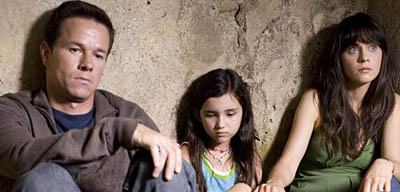
Interestingly, all the deaths prior to Mrs. Jones’ have been strict suicides. The contaminated die but show no inclination of bringing others down with them. Mrs. Jones is the first and only person to do so: she kills herself by thrusting her head through every window on the first floor of her home, in doing so allowing the wind blown contagion to enter the house and expose those within the house to the contagion. This adds the possibility that the contagion or virus may have an evolutional character.
This dynamics of the plot relates to another Shyamalan theme: pit people with problems together in a time of crisis, and watch them grow stronger and resolve their issues (we see it in Signs, Sixth Sense, Unbreakable, and The Village). This is an aspect of what criminologist Mark Seltzer has called America’s penchant for being a ‘wound culture’: a culture that bonds together in times of crisis or through tragedy. Like in The Village, salvation comes (or is hoped for) through a pre-modern or pre-technological element. Elliot comes to the decision that if they are going to die, then he wants to be together with his wife. For the first time a rationalist makes an irrational decision, since going out into the air will surely lead to him catching the contagion and killing himself. As he leaves the safety of his house into the fresh air, so too do Alma and Jess. They meet and hold hands, braced for their final moment together. But nothing happens. A wind passes through them but they survive. In voice-over we hear Elliot speculate that the crisis must have passed moments before they stepped outside. This seems to be corroborated by TV experts who have no real explanation for why it started the day before and ended the next morning. Or what caused it to start and stop in the first place. (The media, represented by TV shows that interview doctors and academics and scientists –police and government are symbolically absent– and only one military man, a young private, is part of the attempted solution).
However, knowing of Shyamalan’s deep-seated romanticism and humanism, there is also the distinct possibility that it was the power of (their) true love that stopped the epidemic. If the stuff Elliot and the neo-hippy, hot dog-loving botanist talk about regards the plant systems in-born defense mechanisms to energies around them, and the fact that humans also give out an energy depending on their emotional state, has some truth to it, then perhaps it was the combined energies of their love that stopped the plant neurotoxins from being emitted? In fact, just before they exit into the open air Elliot and Alma talk about the mood ring and the different colors it was when they first met; and this is brought up earlier by Elliot in the diner scene where he tries to comfort a sad Jess by saying that the yellow color of the ring means she will be smiling soon, forcing a self-prophecy to come true. In terms of explaining the cause of this event, The Happening recalls Night of the Living Dead and The Birds (especially the latter, which it emulates in many respects) in that many theories are offered but not one given as the definitive reason. At first it is thought to be a terrorist attack; then perhaps a nuclear spill from one of the fifteen nuclear plants in the area; or the government experimenting with an antidote to chemical warfare; or a weird environmental/natural reaction whereby plant life send out airborne toxins as a defense mechanism against the many unnatural (or natural) toxins humans have been injecting or emitting into the air. This latter theory is questioned by TV experts because the event has only occurred in this one secluded area, and during a specific time frame. If it is an environmental warning, then wouldn’t it be spreading in other parts of the world? Well, this only sets up the final scene, following the one where Alma learns she is pregnant. The scene cuts to the Paris Luxembourg Garden, where the same set of symptoms seen at the beginning in Central Park are beginning all over again. Like in The Birds, The Happening has an open ending, suggesting that perhaps it is the beginning of the end, an apocalyptic ending caused by our own heedless treatment of the earth. What is interesting in terms of genre, is that there is no government presence in the film, whereas in most nature gone amok films (Monolith Monsters, This Island Terror, The Deadly Mantis, Them) the government and/or military are united as part of the solution. Perhaps Shyamalan’s point is that it is up to us as citizens of the world to help stop this environmental mess we are in and stop looking for guidance from the government?
Although thematically rich and cinematically intelligent, the weakest part of the film is the characterisation of Elliot and Alma, who appear too innocent or perfect to be believable characters to a cynical audience of today. Feminists will no doubt find much to loath in the characterisation of Elliot’s wife Alma, one of the most passive female characters to grace a major film in years. She is not given a function or purpose other than maternal/biological. We don’t know what she does for a living and the ‘happy’ ending is marked by the knowledge that she has become pregnant. Audiences will certainly chuckle when they discover that the angst Alma feels over her betrayal of Elliot’s trust is not because she slept with another man, but had coffee with a co-worker! Elliot is perfect, always thinking for others, respectful, kind, a leader, while she is a naïve innocent, happy to give complete control over to Elliot. And Elliot grudgingly assumes the role of alpha male/leader. For example, in one scene Elliot, Alma, Jess, and a group of strangers trying to stay one step ahead of the epidemic must act quickly on their next decision. With Alma leading the way, everyone yells at Elliot pressuring him to come up with the next plan of action. Shyamalan captures Elliot’s stress in an extreme close-up as he asks for “just another second” to think things through. He comes up with a ‘theory,’ as all scientist must, abiding by his own mantra: the contagion seems to occur when there are large groups of people, with the reasoning that the more people, the more human body energy being produced, and hence the more cause for the plants to react. It seems to work, so they splinter off into smaller groups. But the theory breaks down with Mrs. Jones, who gets contaminated alone in her garden and we never know whether the theory was wrong or the plants just adapted, or perhaps because Mrs. Jones, a hermit, had enough energy for a dozen people!
Shyamalan could never be mistaken for Ernst Lubitsch, and he shows his heavy hand at comedy once again in The Happening. Inspired by a loony botanist character who converses with his plants, Elliot tries to reason with a large plant in a home they have temporally taken refuge in. Only later does he (and the audience) realize that the house they are in is a ‘model home’ and everything inside it –including the plant– is fake (“I’m speaking to a plastic plant!”). The scene is at best cute, but works as a reference to the many hapless victims from the 1950s sci-fi films who try to speak to the alien before they are zapped by a bolt of ray.
I would like to conclude by taking issue with a recent review of the film in the excellent Canadian magazine Cinema Scope, (Issue 35, Summer 2008, 78-79) by Adam Nayman. Just as the French often go overboard in their valuation of certain directors (Shyamalan in fact being one, Clint Eastwood and Jerry Lewis two other examples), it appears that Shyamalan has become the ipso facto whipping boy for North American critics, partly because he always strives for some form of social commentary in his otherwise populist films. I agree that his works can sometimes be too strident in their message, but at least his films are always intelligent cinematically (subtle mise en scene, complex camera movements, sustained use of long takes rather than quickly edited scenes, etc.), even when the plot or message may not be too subtle. In this case Nayman reaps one stinging criticism after another but without ever giving supportive claims to back up the stated weaknesses of the film. For example, he correctly parallels the film’s beginning with Invasion of the Body Snatchers, and then writes, “…the homage extends into the should-be-terrific opening scene….” His main support as to why the scene is not “terrific” is because “the director is not comfortable with gore….” What this means exactly is a mystery, since I felt that the scene was very effective and frightening, for all the reasons noted in my earlier discussion of the opening (the foreshadowing credit sequence, the way the tension mounts slowly and the formally contrived compositions suggest a break in the natural order of things, the great startle edit of the first worker falling to the ground, etc.). More annoying is Nayman’s later equation of a fictional character’s actions and belief system with the director’s. Nayman rightly notes a thematic element across Shyamalan’s films of characters that willingly set themselves off from the world, characters that “live in a bubble” (79). He then relates this to the central plot thrust in The Happening, and writes, “So in The Happening, when Elliot concludes, “We’ve got to get away from other people,” it’s more than a plot point: it’s the author’s rallying cry.” First of all, as Nayman acknowledges but severely underestimates, the idea of keeping away from groups of people is a necessary plot point for survival, since Elliot deduces that the more human energy being emitted makes the plants more likely to sense a threat and strike a self-defensive attack. It also justifies the necessary drive to create action scenes —counterpoising large and small groups of people across wide open spaces— and place the two leads into increasingly isolated spaces so they can express their selfless love for each other. For Nayman this is no longer simply a neat (and very, very, very common) horror device for generating the sense of threat, suspense, and fear, but becomes, “an isolation fetish” (78). It is all too easy to compare fictional characters with their creators, and make autobiographical links, in this case assuming that because a fictional character wants to be isolated, the artist must also crave the same. The creative process doesn’t work that linearly. Every aspect of the fictional world derives in some primal way from the author; but there is no valid reason to believe that one connection is any more directly an authorial wish than an authorial fantasy or a reflection of an opposing desire, such as a reflection of a personal fear or concern. For example, whose to say that Shyamalan’s recurring use of isolated communities is not an expression of a desire to live in isolation –as Nayman implies– but a fear of living in isolation? Or a bit of both. Or neither. And in the end, do we really want an artistic playing field where fictional words are always seen as a direct expression of the author?



